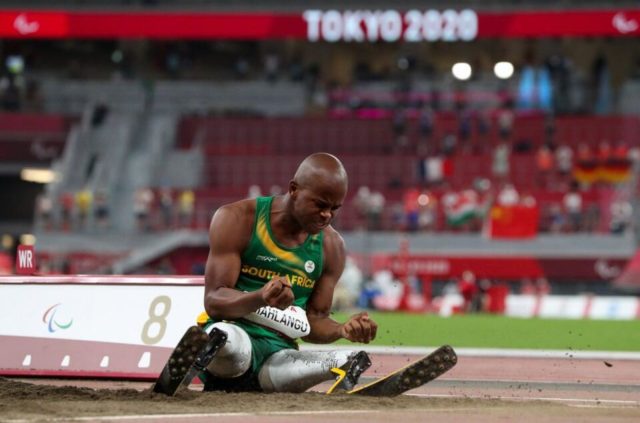‘I hope that this can bring a bit of hope to South Africa – that no matter what our colour is, no matter where we come from, no matter what we do, that we all are humans.’
CAPE TOWN – Ntando Mahlangu had only recently decided to compete in the long jump at the Tokyo Paralympics, and the decision paid dividends when he claimed a gold medal in the T63 class on Saturday.
In addition, he produced a world-record jump on two occasions in the T61 category – with the final being a combined class of T61 and T63 for double amputees – leaping to 7.02m in his first attempt and then 7.17m in his final jump.
It was a memorable night for Team South Africa on the athletics track, as Anrune Weyers also grabbed a gold medal in the women’s 400m T47 class in a time of 56.05 seconds, providing the country’s first two podium finishes in Tokyo.
Mahlangu was initially only running in the 200m T61 category – after he had won a silver in the 200m T42 race at Rio 2016 and finished fourth in the long jump as a 14-year-old – as the jumping had a negative effect on his lower back.
Less than two months ago, the 19-year-old chose to dive into the sandpit once more, and the move paid off handsomely at the Tokyo Stadium on Saturday.
Heading into the final round, he was in a bronze-medal position with his first jump of 7.02m, but said a message from one of his coaches back in Pretoria, Neil Cornelius, inspired him to leap to 7.17m – another world record in the T61 class.
“This is not my medal. So much work was put in it back at home. My coach is also coaching from home, and I am sure he is super excited now!” Mahlangu said from Tokyo.
“What he said on my last jump, he said ‘Stop kicking it, just give it your best. I know you have it in you’, and at the end, jumping 7.17m – taking me from bronze back to a gold medal …
“It’s such a big honour for me to win as this is a difficult class – a combined class (T61 and T63). I’m honoured to be the gold medallist.
“It’s such a great step I took. I had to trust the process when I took the decision six weeks back – I only started training six weeks back. I’m actually super excited for the future. Long jump T63 class is going to be interesting, and like I said, this medal is not mine. I represent it. The long jump (medal), I dedicate to the people of Japan for having us here.”
It was also an unforgettable night for the 28-year-old Weyers, who had to recover from Covid-19 a month ago and managed to make it to Tokyo to chase a gold.
Weyers had claimed a 400m silver at Rio 2016, and a silver and bronze respectively in the 400m and 200m T46 events at London 2012.
“This medal means so much to me – not just the medal, but the race itself. For me being here and beating Covid. It’s a really big gift, just running with God and being healthy and breathing,” said Weyers, whose left arm is amputated below the elbow.
“I was quite overwhelmed with my emotions afterwards. I thought my dream was over to compete at these Games.
“It’s spectacular to represent our country, but it’s not always about the medal. It’s about executing what you trained for, for five years, and trusting what you do as an athlete.
“I am really proud of him (Mahlangu). I followed Ntando’s story since the day he got the prosthetic legs, and seeing him matured and being so humble and such an incredible athlete is really special.
“I hope that this can be a bit of hope to South Africa – that no matter what our colour is, no matter where we come from, no matter what we do, that we all are humans.
“And may we celebrate that and may the future of South Africa look better, in terms of equality and in terms of how we see human beings – because we are all human beings, no matter where you come from and what your skin colour is.”
@ashfakmohamed








